Naqlun (Egypt)
The monastery of Nekloni, excavations in 2011
Dates: 17 September – 13 October 2011
Team:
Prof. Włodzimierz Godlewski, director, archaeologist (Institute of Archaeology, University of Warsaw)
Assist. Prof. Tomasz Derda, papyrologist (Institute of Archaeology, University of Warsaw)
Dr. Dorota Dzierzbicka, archaeologist (Institute of Archaeology, University of Warsaw)
Barbara Czaja-Szewczak, textile conservator (Conservation Labs, Palace-Museum Wilanów)
Katarzyna Danys-Lasek, pottery expert (freelance)
Szymon Maślak, archaeologist (PCMA)
Marzena Ożarek, anthropologist (Institute of Archaeology, University of Warsaw)
Władysław Weker, metal conservator (State Archaeological Museum, Warsaw)
Joanna Ciesielska, student (Institute of Archaeology, University of Warsaw)
Mabruk Ahmed Tawfik, SCA Inspector in Fayum
Ibrahim el Ragab, SCA Storehouse in Naqlun
CENTRAL COMPLEX ON KOM A
The original early 6th century hermitage on Kom A in the central part of the Naqlun complex comprised a tower (Building A) and two buildings: AA.30 and J. It grew successively, adding the rooms belonging to structures AA.40 and AA.50, even as Building J was redesigned and shut off from the complex when its northern entrances from street S.1 were blocked. By the 8th century there were two separate complexes: the old Hermitage A with Buildings AA.30, 40 and 50) and Building J, which was incorporated into the newly built complex on the south, erected here on top of a rocky rise. A fire in the middle of the 10th century destroyed this arrangement and the buildings appear to have been abandoned. More than a hundred years later, in the 12th century, a cemetery was located in the ruins. In 2011, the mission continued work in Hermitage A (rooms AA.40.6 and 7; AA.50.2-3) and in Building J (unit BJ.11).
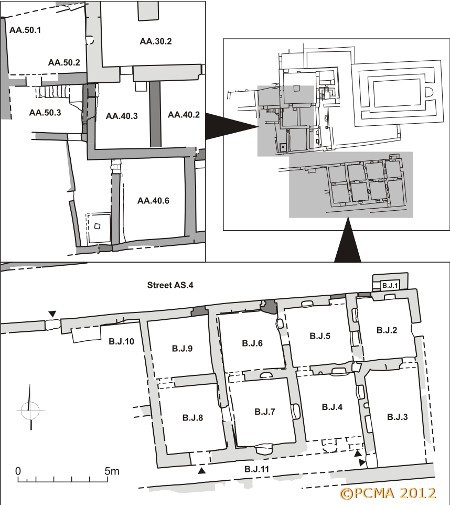
BUILDING AA.40
Two rooms of this structure were explored this year. Room AA.40.6 was excavated completely (for the previous season, see the Naqlun 2010 Newsletter), revealing its western part with a passageway to Building AA.50. It was a kind of narrow vestibule, measuring 5.84 x 1.06, originally accessible from alleys on the south and west. After a basin had been built in its southern part, the room was accessible only from room AA.50.3. Room AA.40.7 was located at the southern entrance to the complex and it may have been where a doorman lived. Found inside this small room, measuring 4.00 m x 2.00 m, was a small limestone basin (H.24 cm; L.85 cm; W.47 cm) and a deposit of tableware and kitchenware datable to the 10th century.
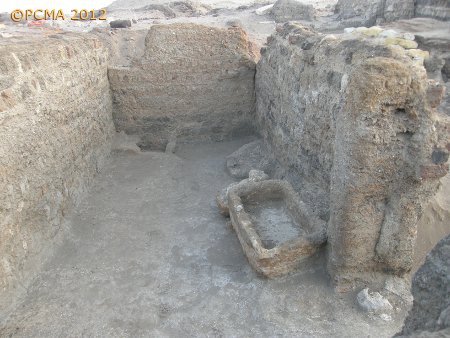
BUILDING AA.50
Rooms AA.50.2 and 3, the eastern ends of which were excavated this season, constituted part of the central monastic complex enlarged in the 8th century. The staircase in AA.50.3, which was preserved up to the first landing, had led once most probably to the upper floor of Building AA.40.
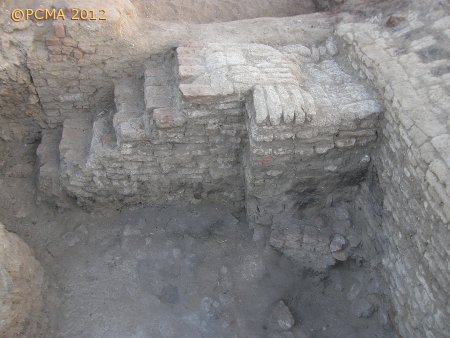
BUILDING J
BJ.11 at the southern side of the structure was a narrow passage running by the southern façade, giving entry into the building in its last phase of use (8th–10th century). The floor level in the passage was 90 cm above walking level inside the building rooms. The south wall of BJ.11, preserved residually, was erected on a rocky rise to the south of the complex, occupied by architecture which has been recognized only sketchily so far.
CEMETERY A
Burials forming part of Cemetery A were explored in the ruins of the excavated rooms (AA.40.6 and AA.40.7, as well as AA.50.3). Of the 18 graves which were excavated, nine were male, five female, and four children. All burials except one (T.476) were preserved in skeletal form, their garments and shrouds, coffins and biers completely decomposed. In three graves small glass flasks were found, and one burial contained a bronze belt buckle. Simple jewellery was found only in children’s graves.
Fragments of garments, that is, tunics and a silk sash decorated with six tassels, were found in the partly looted grave T.476. The sash is unparalleled among the textiles uncovered in Cemetery A in Naqlun.
RUBBISH DUMP ON SITE B
Continued exploration of the rubbish dump on kom B centered on two contiguous trenches excavated directly to the west of the trench explored in this area in 2009. This has brought the total excavated area in the rubbish dump up to approximately 42 square meters.
In the eastern and northern part, it turned out that pits had been cut into the dump. A subterranean mud-brick structure (crypts?) was found at the bottom of these pits. However, the layers of refuse were otherwise undisturbed and were explored to bedrock in eight arbitrary layers. The excavated sector of the dump contained a large variety of material, which provided a great deal of information on several different aspects of monastic life in the central part of the complex in the period when this part of the dump was in use (approximately from the early 6th to the first half of the 8th century). The strata included kitchen refuse, among which were amphorae, cooking pots and tableware, mud stoppers, and food leftovers (animal bones, mollusk shells, fruit pits, etc.). In addition, over eighty diagnostic glass fragments were registered, testifying to the use of glass plates, bowls and cups, as well as wine glasses in the monastery. Among the glass finds there were also fragments of conical lamps and stemmed polycandelion lamps, which, together with a nearly complete earthenware lamp and several wicks, produced information on the monastery’s repertoire of lighting devices.
Fragments of painted and white plaster, as well as fragments of flat roofs gave an idea of the interior decoration and general appearance of the monastic buildings. They may have come from clearance of buildings that had fallen into disuse or were adapted to new purposes. Among the numerous wood fragments there were several pieces that could have been furniture parts. A large assemblage pointed to industrial activities, e.g., textile making (refuse from flax processing, as well as numerous fibers and threads). Some organic remains do not seem to have been leftovers from human consumption, but from animal fodder and from material used for burning. Last but not least, the strata contained personal effects: fragments of textiles and leather objects, as well as texts on papyrus, letters and documents, written in Greek.
SITE K.1 (NORTHERN BUILDING)
A new site (K.1) was investigated at the northernmost point of the monastic complex of Nekloni, approximately 50 m north of the buildings on site D. This severely damaged Northern Building was destroyed in a huge fire and its mud-brick walls were disassembled down to foundation level. Two rooms and a storage pit uncovered in the northeastern part of the building produced important archaeological evidence for the dating of this structure and its furnishings. The walls of the structure, which was most probably a single-storey building, were coated with mud plaster on the inside. Judging by the preserved fragments, drawings and inscriptions in Coptic were found ion these walls. The preserved floors were also well coated with a thick layer of mud mortar. Found inside the main room were local amphorae in a good state of preservation, decorated on the shoulders with combed bands (horizontal and wavy lines), as well as numerous broken tall vessels and storage jars. They had been stored inside and were buried under a collapse of the burning roof of the building and bricks from its walls. Ten Coptic and Arabic texts on paper including completely preserved documents were preserved inside a storage pit in the northeastern part of the building. The most striking discovery was a deposit of votive objects wrapped in a linen cloth found in the northeastern corner of the main room. It consists of four small crosses cast of lead and a round lead plaque with an Arabic inscription on both sides (God is one, he did not beget, nor was he begotten.) which may be a fragment of the Sura 112, the manifest of Islamic but also Coptic monotheism. The crosses are richly decorated, with figural representations (crucifixion on one side and Virgin Mary on the other) and symbols on both sides. They were very carefully made using two different molds. Votive objects of this type are very rare in Coptic art. Their dating is based on the archaeological context inside this severely damaged room. They were manufactured most probably in the 10th century. The bundle also contained a small bell, attested in medieval iconography as an element of the outer garment of a bishop or priest and Late Antique horse trappings (Qustul).
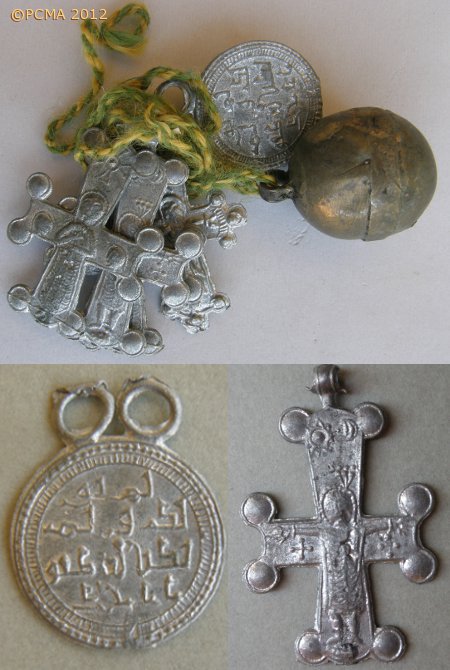
CONSERVATION
Władysław Weker carried out the conservation of metal objects and jewellery found in previous seasons (1992–2010) and this year in graves on Cemetery A, in rooms of Building J and in the refuse dump (Site B). A total of 49 objects were subjected to conservation treatment: vessels, elements of dress, belt buckles, rings, earrings, silver and bronze coins, and fittings of a wooden casket which had been burnt in room BJ.8.
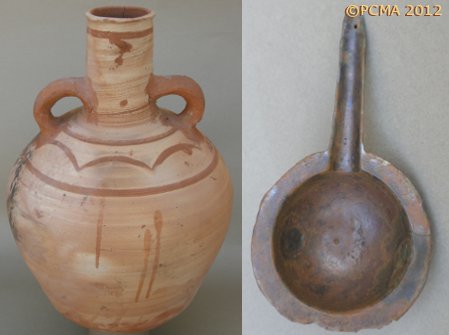
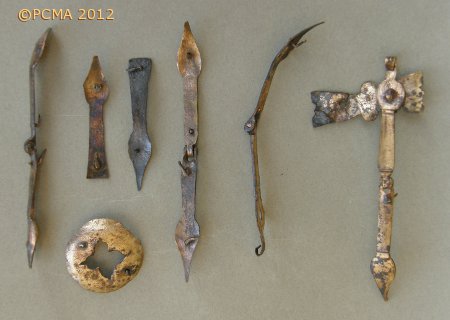
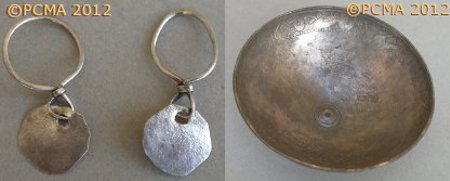
Other conservation work was conducted on documents written on papyrus, paper and parchment. The documents were unfolded, cleaned and secured between glass panes. Some of the uncovered pottery vessels were cleaned and reassembled. All of the textiles were cleaned and preserved.
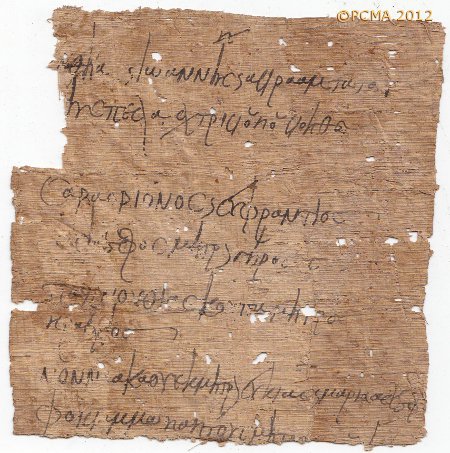
[Text: W. Godlewski]

